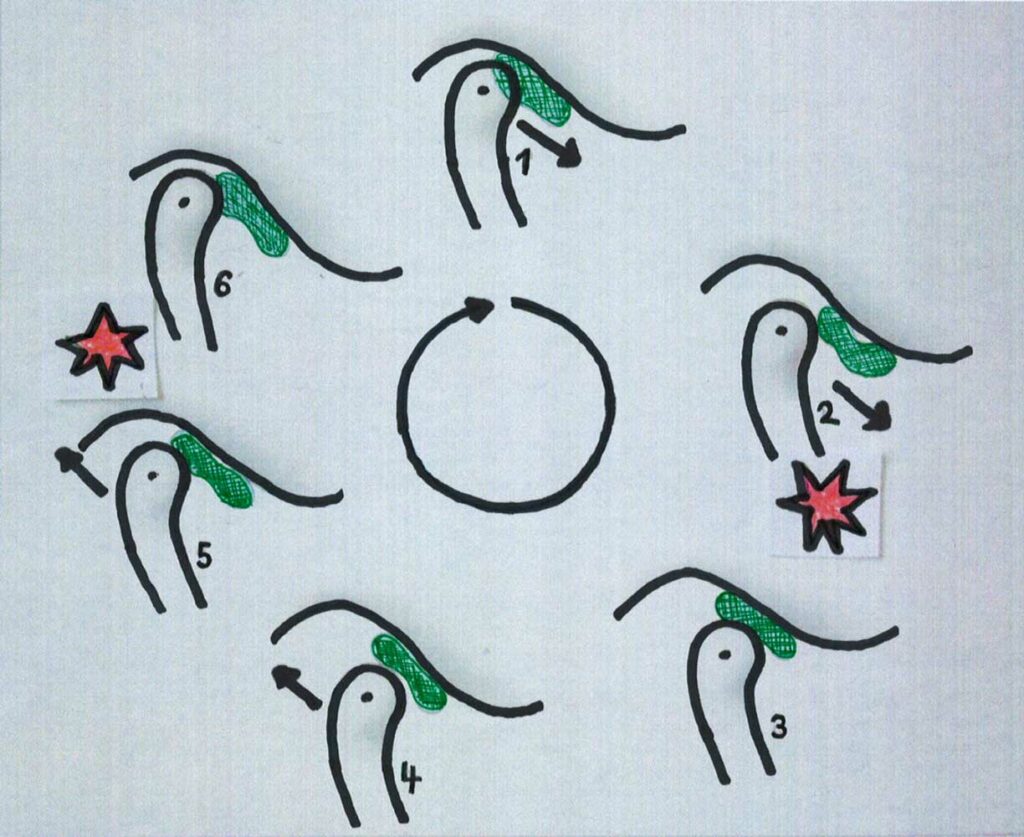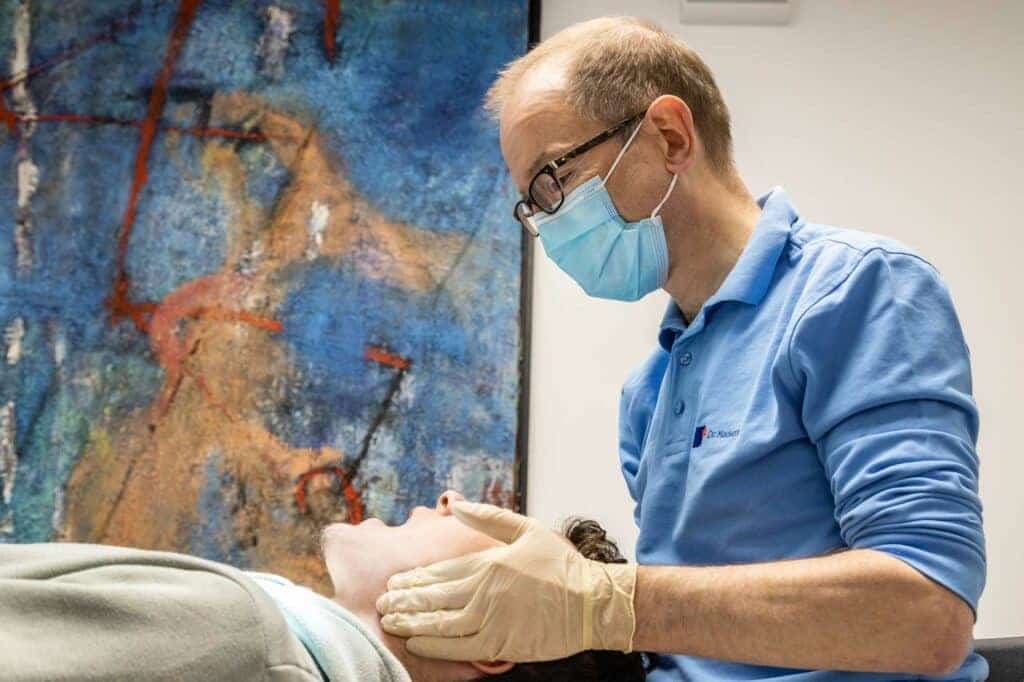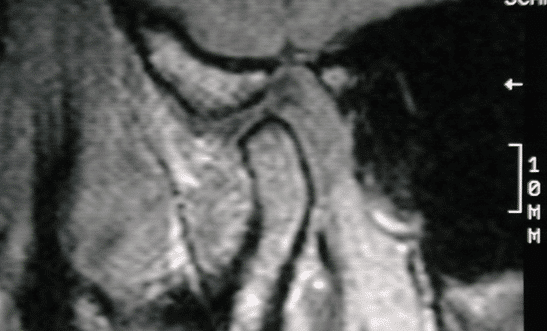Clicking of the Jaw is not an Illness
What is colloquially referred to as “jaw cracking” is actually a noise produced by the temporomandibular joint. Like many other joints in the human body, the temporomandibular joints can develop noises. The most common is a cracking sound when the jaw opens.
Cracking of the temporomandibular joints is almost always due to an anterior position of the joint disc – in technical language: the discus. The discus of the temporomandibular joint is ideally located between the head of the temporomandibular joint and the articular surface of the skull. The joint capsule and the ligaments connect and stabilize the discus with the joint head and the base of the skull.
In many people, the joint capsule and posterior ligaments of the temporomandibular joint stretch somewhat over the course of life. As a result, the discus shifts forward and then lies fully or partially in front of the articular head. When the jaw opens, the discus slides back onto the head of the temporomandibular joint, which may cause a cracking sound.
When the jaw closes, the discus usually slides back down from the condyle without making a noise. This also makes it clear that it is actually not the jaw itself that cracks here, but its joint.
Earlier View: Cracking is an Alarm Signal
In the past, it was assumed in dentistry that “jaw cracking” was a disease. It was assumed that in the long term, cracking would always lead to arthritis and eventually to osteoarthritis of the temporomandibular joints.
Due to this assumption of a steady downward development with a fatal end, often very expensive and invasive therapies were offered for prevention. To this day, the occurrence of a clicking in the temporomandibular joint represents an unresistible temptation for many physicians to bring elaborate diagnostic and therapeutic procedures to their patients.
For this reason, most of the information that can be found on the websites of doctors and other health professionals about “jaw cracking” should only be taken with great caution. The tendency is always that the in itself harmless jaw clicking is dramatized and declared a disease, i.e. pathologized.


Patients Worry About It
Affected patients are often very worried because of the clearly perceptible noise. We can tell them with certain knowledge that the cracking of the “jaw” can simply be ignored and does not usually result in any secondary diseases.
The cracking usually changes in the course of time, it can become louder or quieter, often disappears completely. In no case should such changes in the cracking sound be a cause for concern.
Today’s View: Clicking is Harmless
The current scientific opinion, however, is that “jaw popping” is not a disease, but merely a harmless diagnostic sign of an anterior disc position. An anterior disc position is found in magnetic resonance imaging (MRI) examinations in around one third of the adult population. This does not even necessarily involve cracking noises.
The majority of those affected do not experience any further symptoms due to the cracking. The anterior discus position and the “jaw cracking” often associated with it are therefore very common and ordinary findings that are more likely to be peaceful house guests than threatening intruders.
In fact, many other of the 300 or so human joints can also produce noises such as clicking without anyone being interested. The temporomandibular joint simply has the misfortune of being close to the inner ear, so that those affected hear cracking noises from this joint very loudly via bone conduction.
This also explains why almost 100% of the entries for joint clicking in search engines such as Google relate to the temporomandibular joint. This overrepresentation alone makes it clear that more attention is paid to “jaw popping” than is appropriate.
Therapy for Cracking is Superfluous
Unfortunately, many doctors exploit the existence of a harmless “jaw cracking” to frighten patients with gloomy prognoses and at the same time offer expensive and pointless “therapies” for the supposed illness. This approach is simply the invention of diseases as a business model, known as “disease mongering”.
Unnecessary diagnostic procedures such as computerised jaw measurements and imaging procedures such as MRI and DVT are unnecessary for jaw cracking.
The superfluous therapies range from complex splint therapies, which are charged at several €1,000, to the prosthetic treatment of complete dental arches with crowns or “tabletops”, where €30,000 is charged per jaw. In terms of cost, there are adventurous orthodontic “repositioning therapies” in between, which are intended to restore the ideal relationship between the temporomandibular joint head and the discus.
Unfortunately, surgical reduction of the discus (known as discopexy) is also still offered today, although it is associated with high risks and uncertain benefits. All these therapies are highly invasive, stressful and expensive, but have no proven benefit.
On the contrary, a targeted therapeutic influence on “jaw popping” is not even possible. In the rare cases in which the clicking is so loud that it is disruptive in social life, a minimally invasive surgical procedure on the temporomandibular joint (arthroscopy or arthrocentesis) can bring improvement under favourable circumstances, although success cannot be guaranteed.
While most “cracking therapies” are as superfluous as they are pointless, therapeutic help for pain and restricted movement that may exist at the same time is of course useful. The principles of non-invasive, reversible and cost-effective apply here – or in short: keep your head down.
Radiological Reports
Radiological reports following MRIs of cracking temporomandibular joints often contain dramatic-sounding findings such as ‘subchondral resorption lacunae’, ‘joint space on the right narrowed by 0.4 mm’ or ‘arthrotic remodelling of the temporomandibular joint heads’. Such findings are all to be understood as variations of the normal rather than as signs of disease. The term ‘internal derangement’ of the temporomandibular joints, followed by a grading from I to V, sounds particularly frightening. This simply describes how far the discus deviates forward from its ideal position – however, this does not mean that there is a disease or that the prognosis is poor. ‘Internal derangement grade IV’ is therefore by no means a threatening finding, as the temporomandibular joint usually continues to function without complaint even with a total disc displacement. Those affected with a ‘cracking jaw’ should therefore not be impressed by such reports.
Unfortunately, certain radiological practices with a large catchment area are making a name for themselves here. In this respect, a large radiological practice in Frankfurt am Main, which willingly provides gloomy-sounding diagnostic reports and thus gives referring doctors a pretext for unnecessary treatment – it seems to be a lucrative barter deal for both sides.
The greatest scepticism should also be shown towards the many medical statements on the internet about jaw cracking, whereby the recurring basic pattern is the creation of a threatening backdrop in connection with questionable therapy offers.
Beware of Misinformation
Unfortunately, the internet is full of misleading information about ‘jaw cracking’. This starts with speculative statements about the causes of the clicking or the anterior disc position. In fact, these are generally unknown and, incidentally, completely irrelevant for further treatment.All statements about the danger and need for treatment of cracking should not be taken seriously. All therapy offers for cracking are fundamentally questionable, as there are no possibilities at all to specifically influence cracking. Statements such as ‘Get rid of jaw popping – once and for all!’ and ‘Jaw popping – a treatable disorder’, which give the impression that great masters of the trade can reverse the anterior discus position, are therefore also dubious.
Tip for People with Temporomandibular Joint Clicking
Above all, resist the whispers of enterprising doctors and under no circumstances have expensive and invasive therapies performed because of a trivial “jaw clicking”! Computer measurements should be avoided, as well as MRI examinations, both of which are basically not useful in the case of a jaw clicking as the only finding.
Justifiable indications for an MRI are severe pain in the temporomandibular joint that does not respond to usual therapy or the planning of an operation. However, both of these occur extremely rarely.
In the case of a simple “jaw crack” without pain and movement restrictions, neither in-depth diagnostics nor any therapy is required – do nothing and let it crack is the best strategy!

